Three Extraordinary Dublin Libraries: Don’t Wait for a Rainy Day to Delight in These Irish Treasures
Discover Dublin's literary gems, including Chester Beatty, Marsh's, and Trinity College libraries. Explore rich collections regardless of rain.
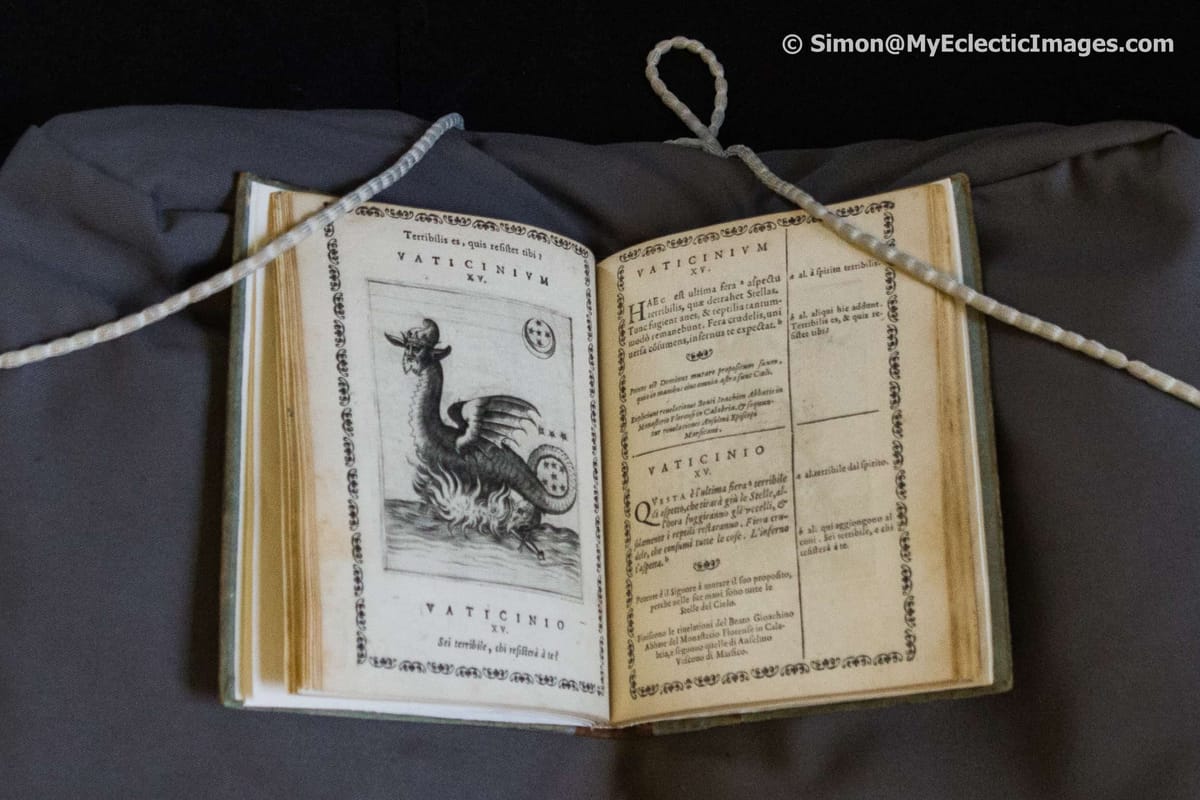
For many, a rainy vacation day is a wasted day. But if you’re fortunate enough to be vacationing in Dublin, rain could be your friend. Especially when you can seek shelter for body and mind in the Chester Beatty Library, Marsh’s Library or the Trinity College Library. In fact, any day is a good time to visit Dublin libraries, one or all of these three remarkable historic havens for book buffs, regardless of the weather.
My husband and I were privileged to be among a small group of travel bloggers on a “Drama of Dublin Tour hosted by Fáilte Ireland”. We spent four days discovering Dublin’s literary, cultural and culinary – not to mention liquid – highlights. Our group visited the three Dublin libraries on separate days and were completely enthralled by their collections, stories and contributions to Dublin and the world.
Chester Beatty Library – Dublin Libraries Our First Stop
Treasures of an Eclectic Collector
The Chester Beatty Library is conveniently located at the South end of the grounds of Dublin Castle.
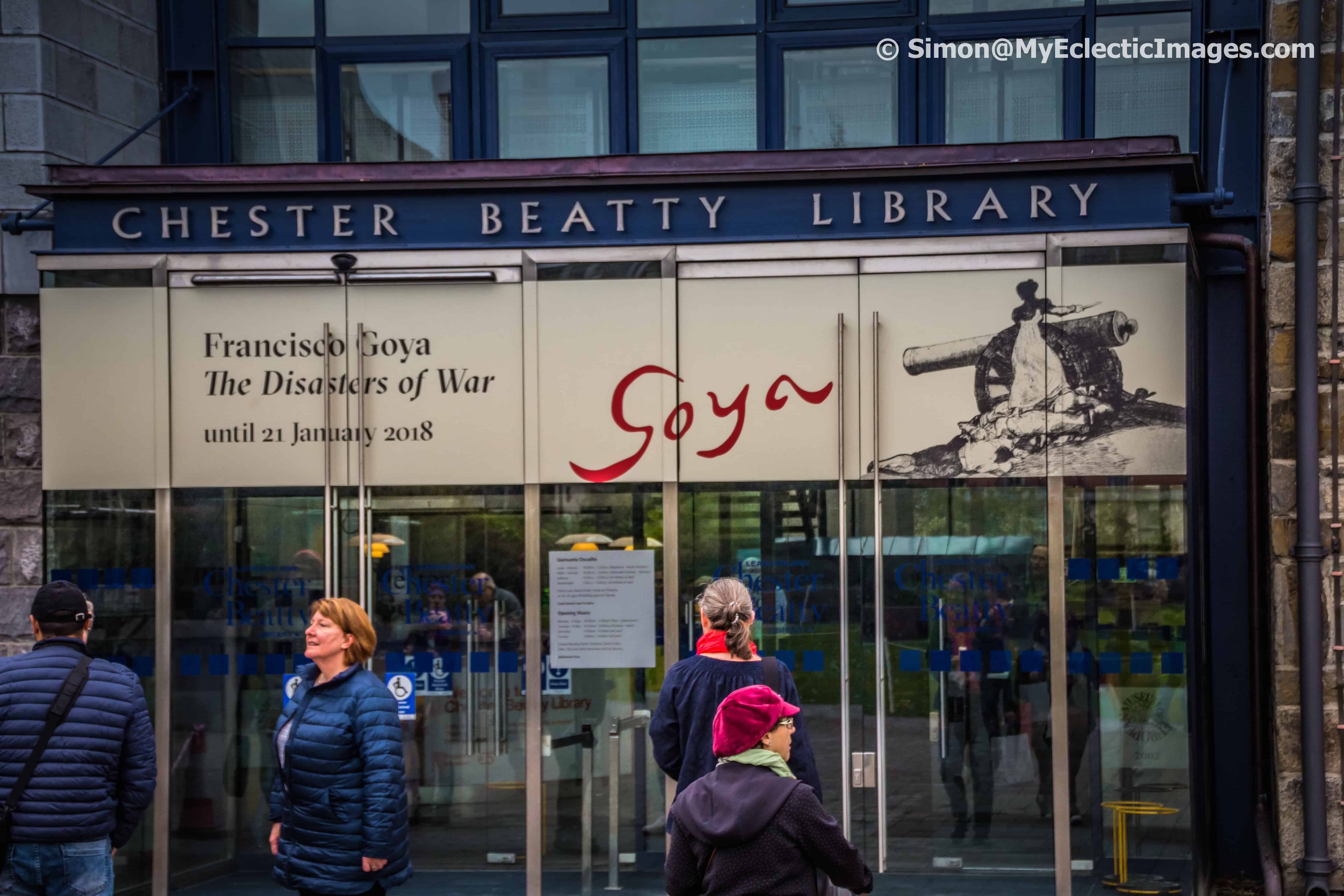
The Library’s collections are housed on two levels. The first floor contains the “Artistic Traditions, while the upper level is dedicated to the “Sacred Traditions”.
Beginning on the lower level, Mary, our enthusiastic and personable guide, led us first to the Asian section and Beatty’s extensive collection of carved Chinese snuff bottles., which he acquired in his 20’s. Then it was on to the priceless jade books, Japanese scrolls with gold leaf and vivid colors of gold, red and black, as well as wood block prints.
Our heads were already spinning with the array of magnificent priceless artifacts, but there was much more to come. In the Western Collection, Mary told the stories behind a 17th century 11-volume set of atlases published by a prominent Dutch family, messages on fragments of pottery dating back to 2500 BC, cuneiform tablets, Armenian books with metal covers, and one of Cicero’s speeches written in Latin on fine vellum that had once belonged to the de Medici family.
Then she showed us a papyrus scroll bearing Egyptian love poems from 1160 BC and books of the dead from 300 BC. The Islamic Collection contained treasures from Persia, Turkey, and India.
Beatty’s eclectic collections span the globe, originating in Asia, the Middle East, North Africa and Europe. They include many priceless objects: a surviving volume of the first illustrated “Life of the Prophet”, the “Gospel of Mani” believed to be the last remaining artifact from Manichaeism, and a 3rd-century Greek papyrus manuscript of the Gospel of Luke.
The Man and His Priceless Gift
Sir Alfred Chester Beatty was born in New York in 1875. Fast forward 32 years, and he is the millionaire owner of multiple mining companies.
Beatty began collecting at an early age – everything from stamps to ancient relics – and never stopped. His extensive world travels enabled him to gather books and works of art, making his collections the finest compilation of manuscripts and books by a private collector in the 20th century. And his collections of Islamic and Far Eastern artifacts are touted as being the most significant in the world.
Shortly after his arrival in Dublin, Beatty opened the original Chester Beatty Library on Shrewsbury Road in 1950. The present library opened on February 7, 2000, the 125th anniversary of Beatty’s birth. The library was named European Museum of the Year in 2002, and by 2015, was receiving over 340,000 visitors.
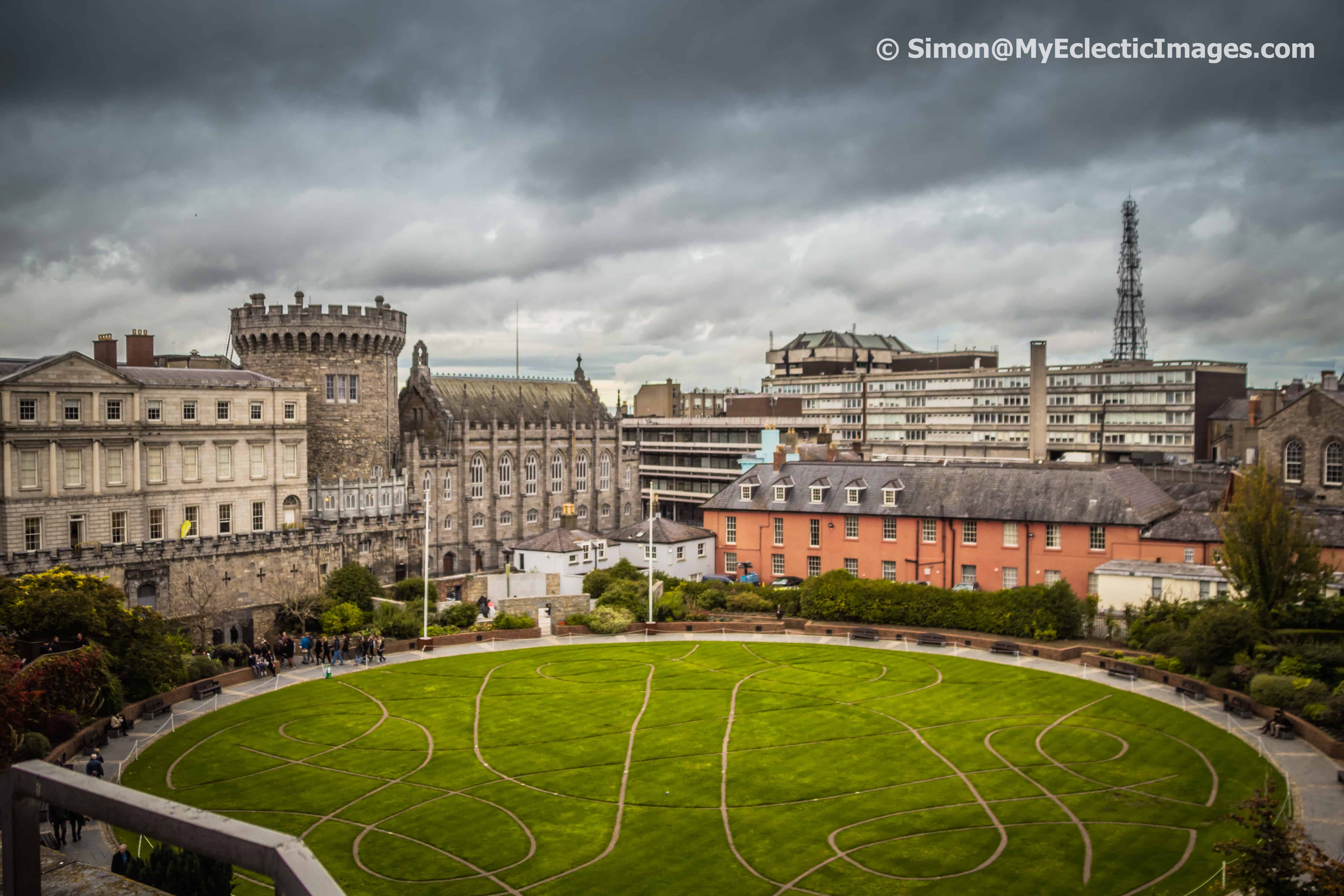
Sir Alfred Chester Beatty died in 1968 at the age of 92. He generously bequeathed his entire collection to the people of Dublin. Mary explained that only one-and-a-half per cent of the collection is on display at any one time. Pieces are rotated, so there will always be something “new” to see each time you visit.
Sadly, we ran out of time before we could explore the second level, but a return visit to the Chester Beatty Library is definitely in order.
If You Go
Chester Beatty Library
Dublin Castle
Dublin, Ireland
+353 1 407 0750
Hours
May 1 – September 30:
Monday – Friday, 10:00am – 5:00pm
Saturday, 11:00am – 5:00pm
Sunday, 1:00am – 5:00pm
October 1 – April 30:
Tuesday – Friday, 10:00am – 5:00pm
Saturday, 11:00am – 5:00pm
Sunday, 1:00am – 5:00pm
Closed: January 1, Good Friday, December 24 – 26, and Monday public holidays.
Admission
Free.
Accessibility
The Library is wheelchair accessible, and many of the most important exhibitions are placed at wheelchair height.
E-guides and audiovisual presentations facilitate access to the collection.
A Braille copy of the Library’s main information leaflet is available at the reception desk.
Marsh’s Library
Treasures of the Library Time Left Behind
Stepping into Marsh’s Library was like stepping 300 years into the past. Perfectly preserved, its original intricately carved oak bookcases stood tall and proud. The majority of the library’s collection of more than 25,000 rare and historically relevant books rested in the exact spots they occupied upon their arrival in the early years of the 18th century.
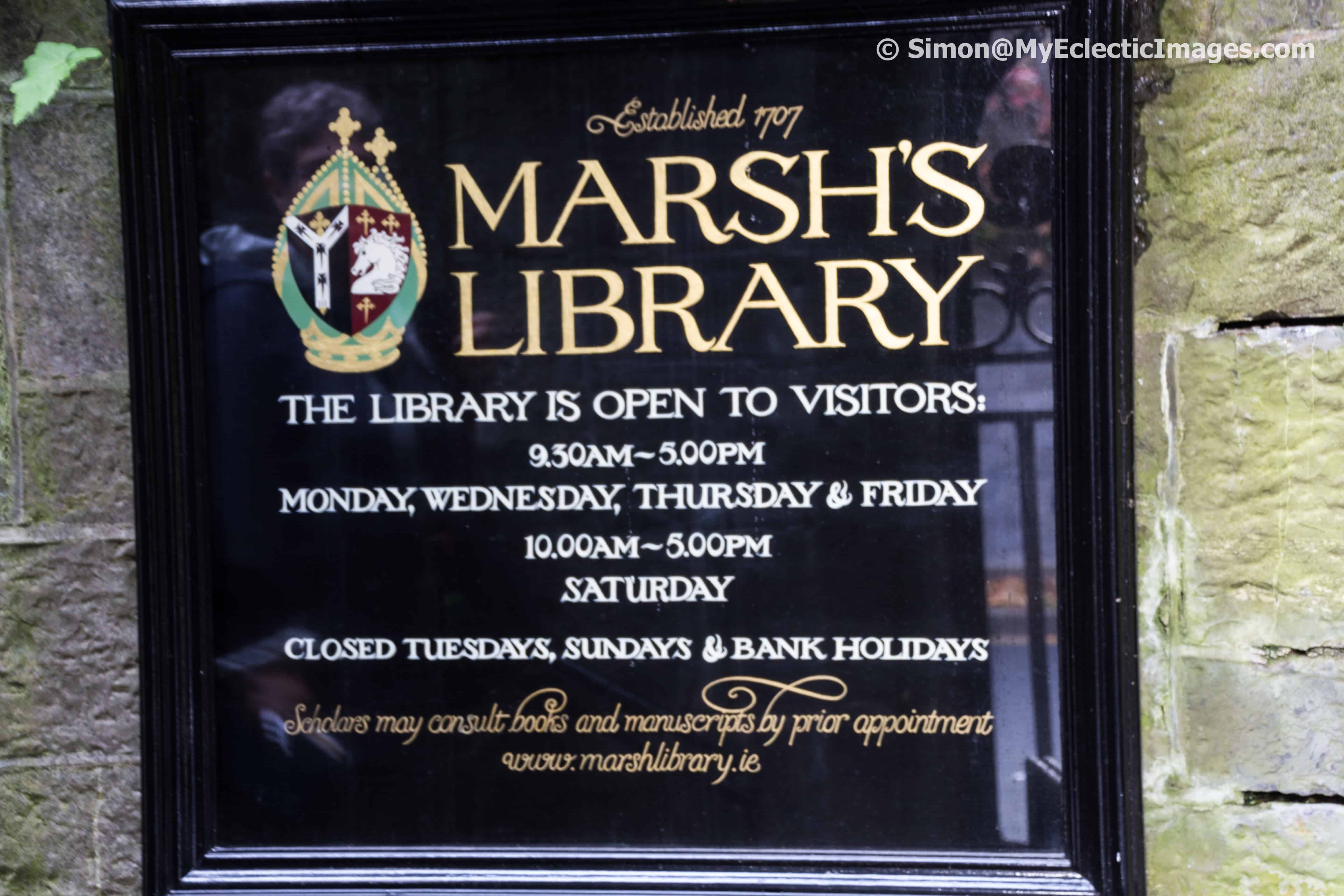
Marsh’s Library is located on St Patrick’s Close, next door to St. Patrick’s Cathedral. The library is still open as an academic and reading library, but these days tourists make up the bulk of its visitors. Special tours designed for children keep youngsters entertained, while remaining factual. Well, perhaps the ghost story may be somewhat subject to doubt.
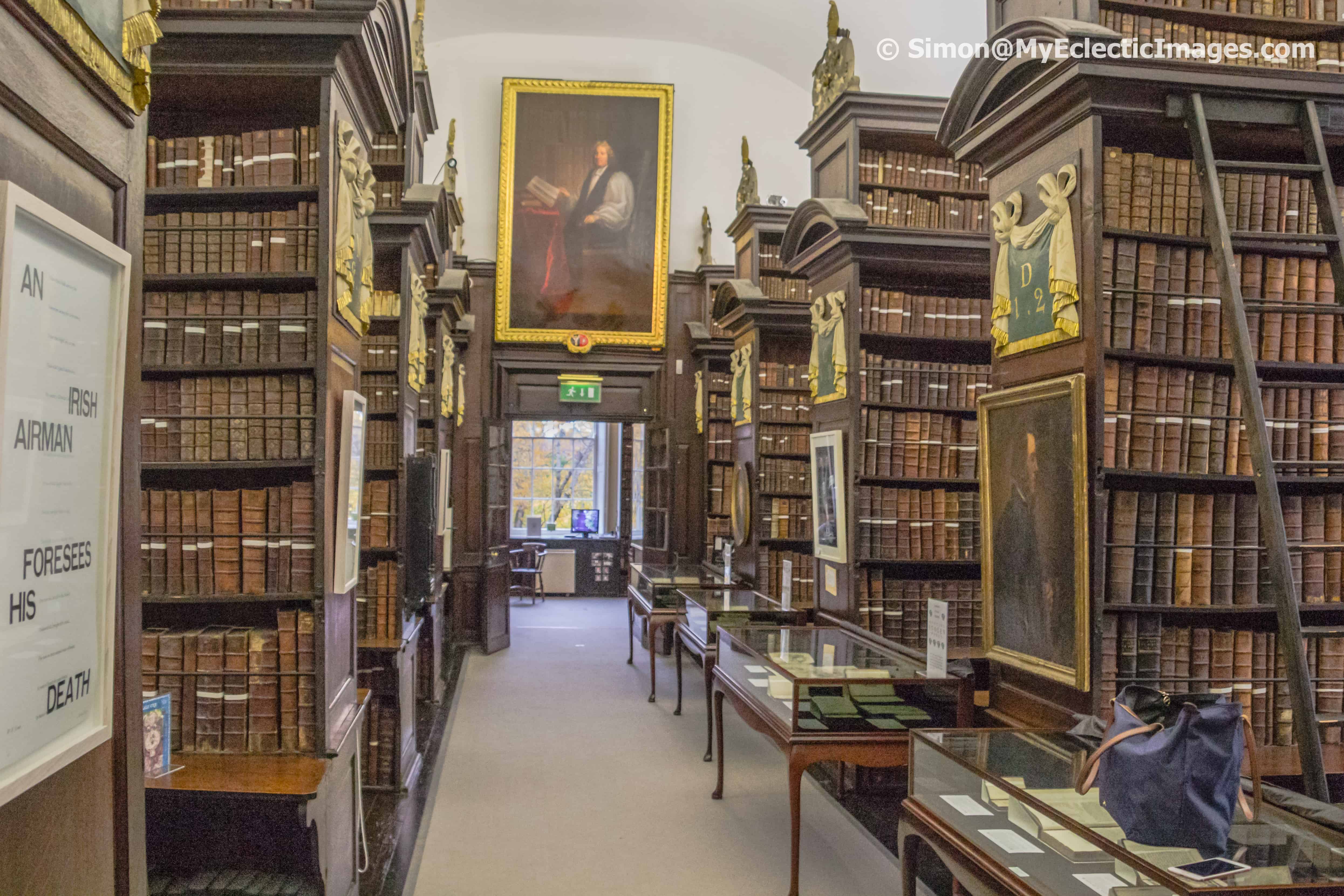
Our guide was Library Director, Dr. Jason McElligott. He began our tour in the first gallery, where a special exhibition on stolen books that had been retrieved or replaced was located.
We next entered what, up until recently, had been the reading room. Jason noted that according to pictures from the 1800s, the tables and chairs we saw had been there for at least 150 years. In this room, a young James Joyce read a book of anti-papal prophesies he wouldn’t have been able to read anywhere else in Dublin.
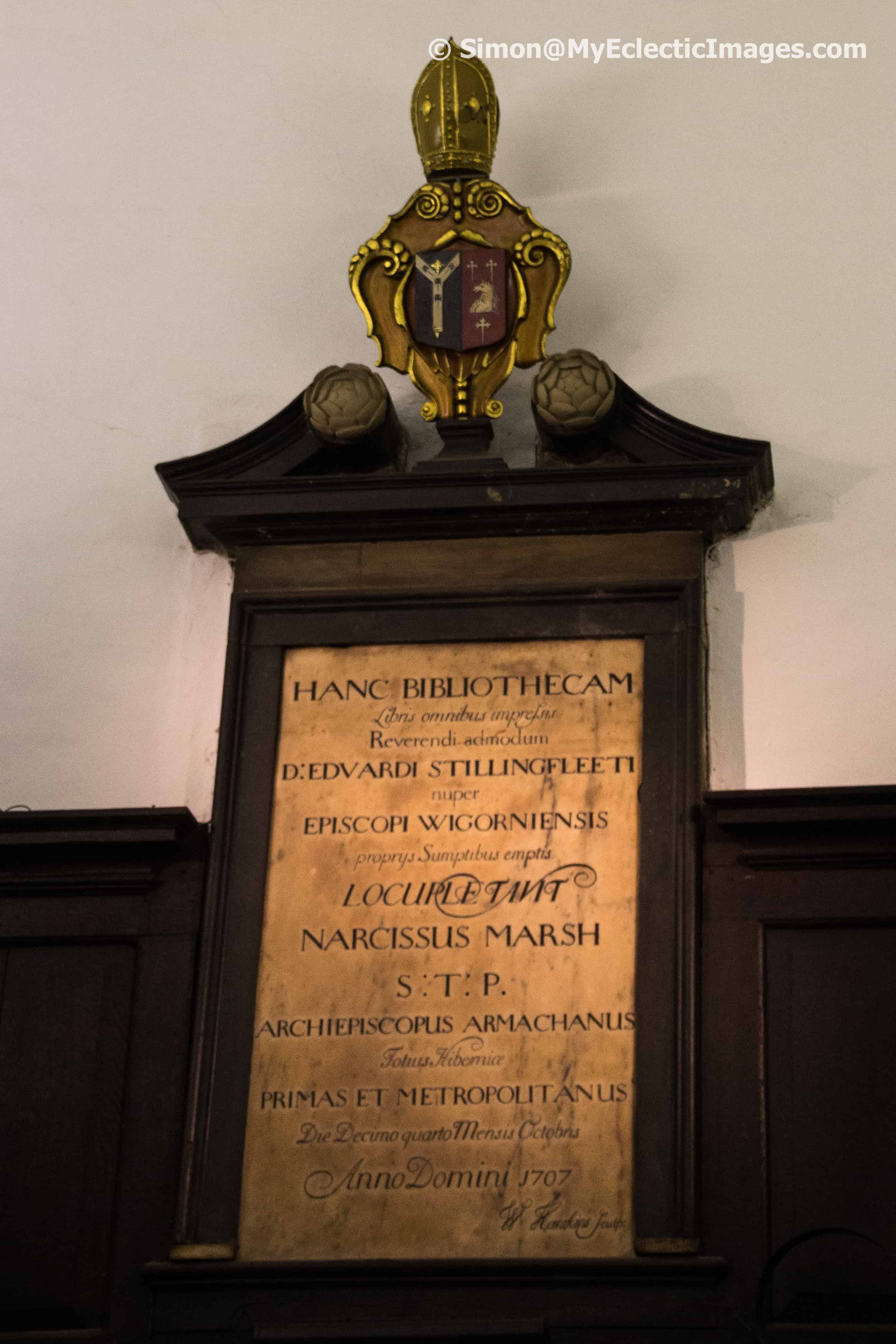
Jason showed us a mid-17th century history book that had been the personal property of Jonathan Swift, which had his written notes on every page of the three-volume text. Next to each and every reference to the Scots – and there were a great many – Swift had written a brutally nasty remark.
Swift hated Marsh with a passion, and never would have donated his books to the library. But they came anyway, through people who had bought them on the open market.
History and Hauntings
Archbishop Narcissus Marsh built and funded his library in 1707. Today, the building is among a handful of 18th century Dublin buildings still in use for its original purpose.
Marsh died in 1713 and is buried outside his library. But according to legend, his ghost still haunts the second gallery, added in 1709.
It seems his 19-year-old niece/housekeeper, Grace, followed her heart and ran off to get married in a tavern. Not wishing for her uncle to find her goodbye note in time to stop her, she allegedly tucked it into a book in the library. The story claims Marsh’s ghost walks the gallery searching for the note he never found.
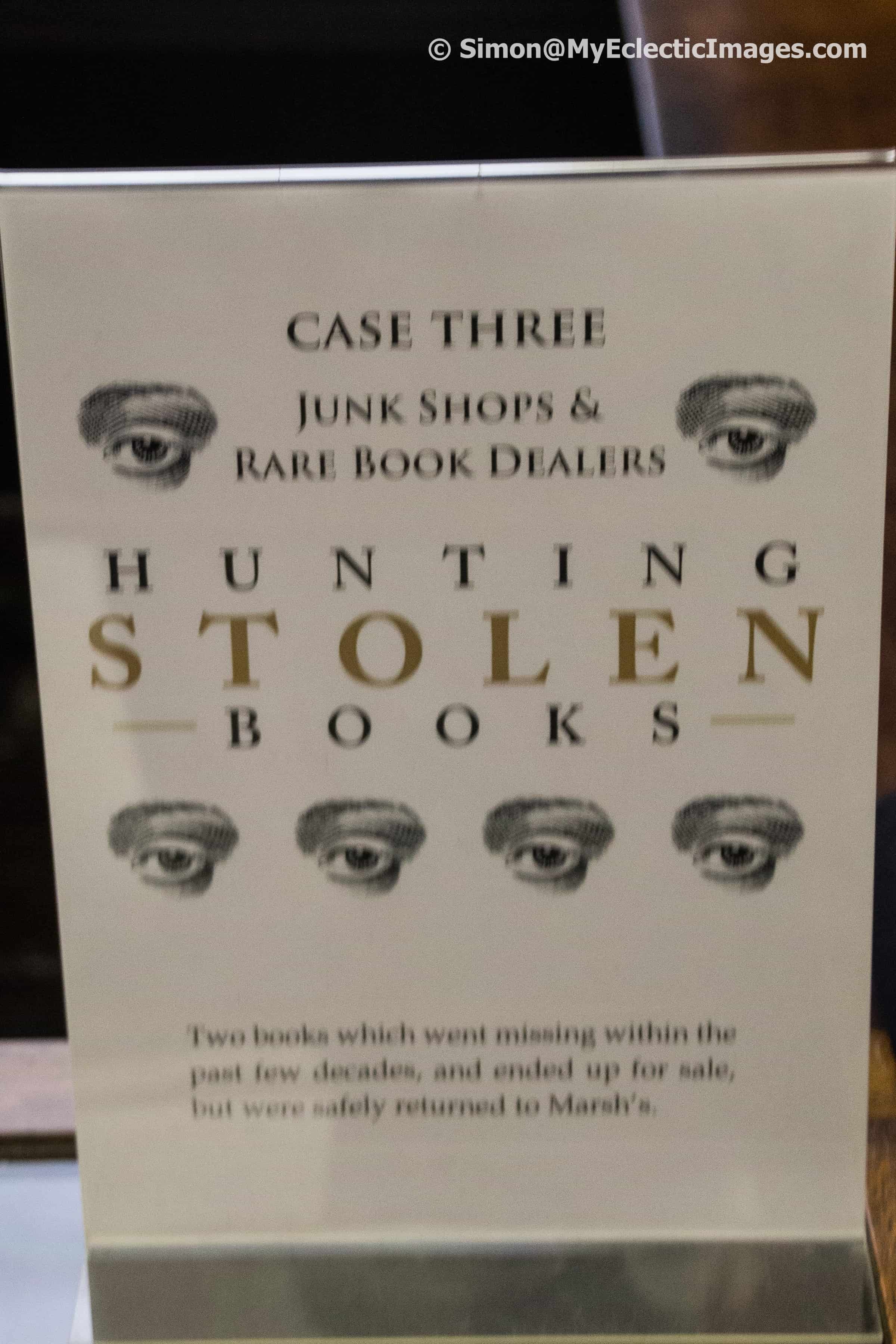
When Jason ushered us into the second gallery, it was easy to understand why some might find the legend of Marsh’s ghost credible. With a North-facing outer wall, and no artificial climate control in the entire building, the temperature in the room felt significantly colder.
Jason pointed out a cupboard where in 1888, a 1500 BC Egyptian mummy was found. The library turned it over to Trinity College, where it was promptly lost. The mummy surfaced several years ago minus its head. This, along with the tiny finger and toenails poking through the bandages, disqualified it from returning to the library.
Three alcoves with wire doors at the back of the gallery were installed in 1766 to curb a growing purloining problem. They were used as cages to lock in readers studying rare books.
Marsh’s was the only public library until the National Library opened in 1878. Because Marsh’s was filled to capacity by 1748, few books were added to the collection. The library became dormant due to lack of modern books. Jason noted Marsh’s Library wouldn’t have survived otherwise. In that instance, a priceless Dublin treasure would have been lost.
If You Go
Marsh’s LibrarySt Patrick’s Close, Wood Quay,
Dublin, Ireland
+353 1 454 3511 information@marshlibrary.ie
Hours
Open to the public Mondays, Wednesdays, Thursdays, and Fridays, 9:30am – 5:00pm
Saturdays,10:00 am – 5:00pm
Closed Tuesdays, Sundays, bank holidays, Christmas Day, and New Year’s Day.
Admission
Adults: €3
Students and seniors: €2
Children under 16: Free
Group tours are available by appointment.
Accessibility
The historic building in which Marsh’s Library is housed is not fully wheelchair accessible. There are several steps on the outside of the building and the galleries are located the top of several flights of stairs. Arrangements can be made in advance for accessing parts of the ground floor.
Trinity College Library
Treasures in the Heart of Academia
The Old Library at Trinity College is home to the highly prized Book of Kells. The college’s nine library buildings are packed with approximately six million books, but it was the Old Library, and the Book of Kells we hungered to see at the last of our three Dublin libraries.
Our guide Anne-Marie greeted us and brought us face-to-face with the Book of Kells. So popular is this 8th century book of the four Gospels, 900,000 visitors paid to see it in 2016.
The Book of Kells was created on the island of Iona, off the Scottish coast.. The book, bound as one volume, was lovingly crafted by monks whose ancestors had relocated from Donegal two centuries earlier. Viking raids forced the monks to flee back to Ireland and settle in Kells, County Meath. The Book of Kells was transferred to Dublin and Trinity College in 1661 for safe keeping from Cromwell’s wrath.
The book was written in Latin and was full of errors, because it was never intended to be read out loud. It was used as a holy relic or ceremonial book. Its fame comes from its stunning artwork and is the oldest manuscript of its time to survive.
The book consists of 340 folios made of calves skin vellum from 185 calves.
In the Book of Kells, Jesus is depicted with red curly hair. Apparently, back then, images of Jesus represented the local population. So, in the Book of Kells he was Irish.
in 1953 the Book of Kells was divided into the four books of the Gospels for conservation purposes. Two volumes are always on display and two secured in a strong room.
Contrary to popular belief, library staff don’t turn a page every day. Pages are turned and volumes rotated approximately every three months.
The Long Room
Following our viewing of the Book of Kells, Anne-Marie led us upstairs to the 213.25 foot Long Room. This section of the Old Library houses 200,000 books from the 15th – 19th century in tall oak bookcases.
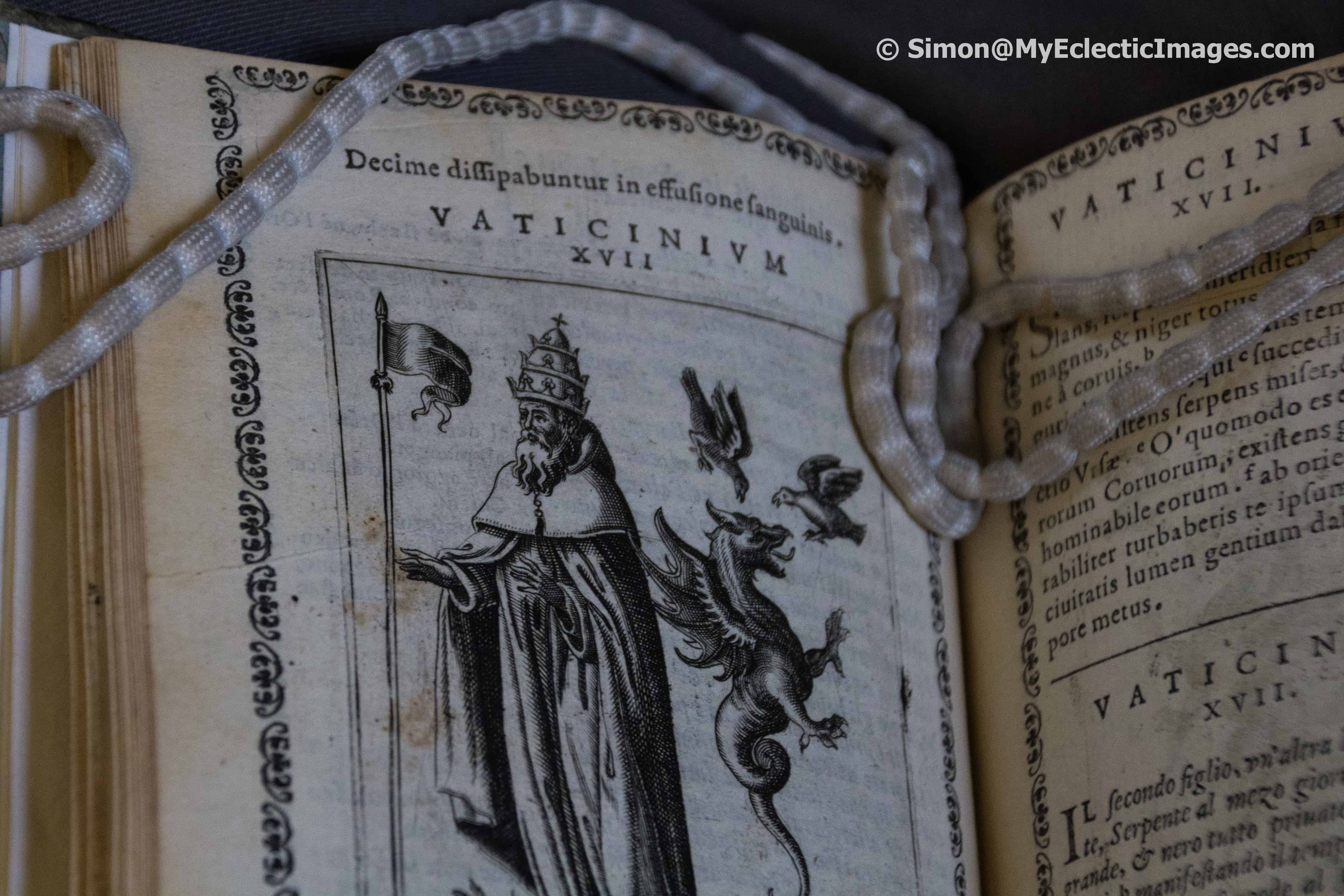
The Old Library was built between 1712 and 1732. There was a definite “old book” smell that reminded me of vanilla and was somehow appropriate in the surroundings in which I found myself.
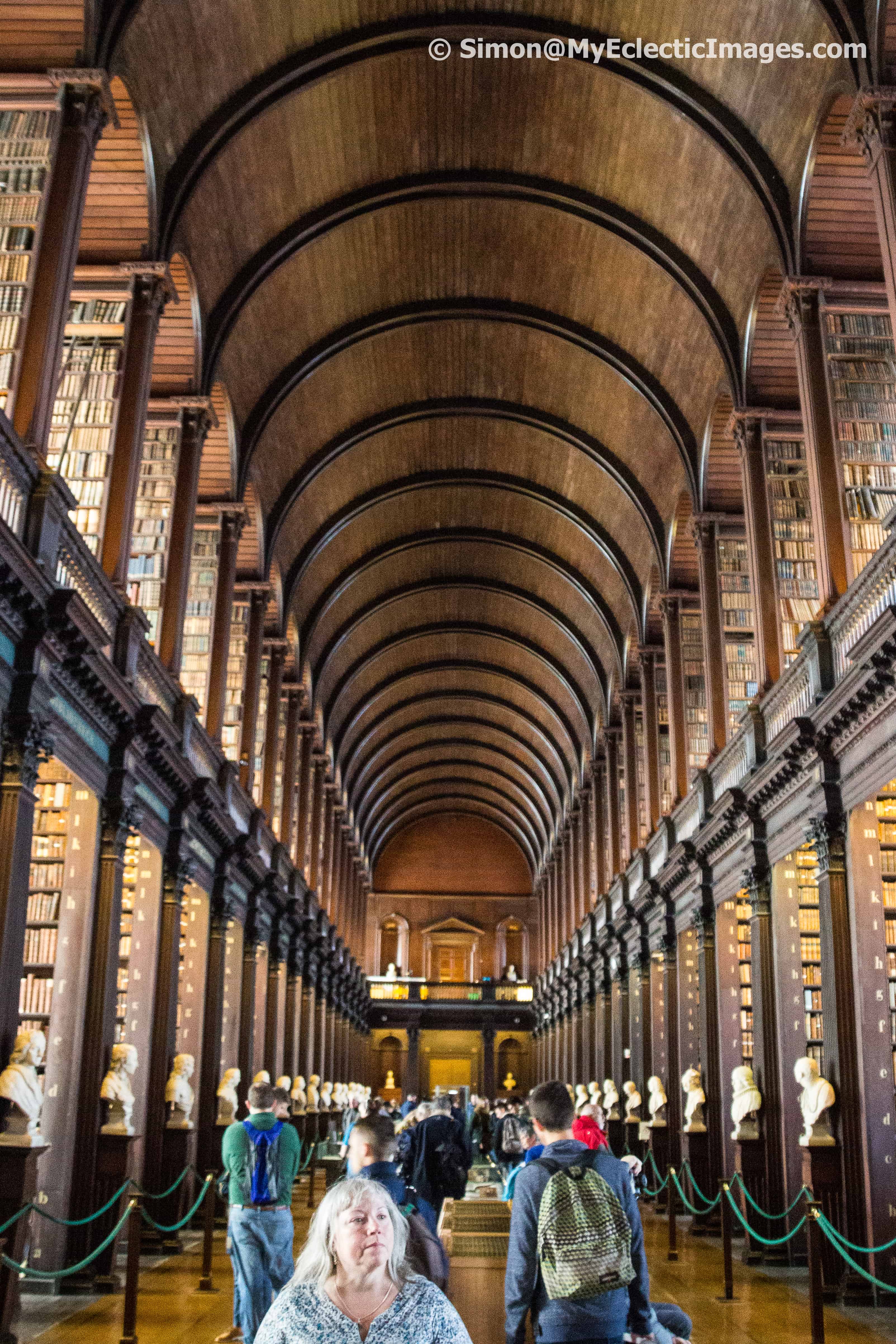
The Long Room was lined on both sides with 48 marble busts of great Western philosophers and writers. The collection began in 1743, and includes Aristotle, Homer, John Locke, Sir Isaac Newton, Plato, William Shakespeare, and Jonathan Swift. Ann-Marie noted that all the busts were of men, because women weren’t present at Trinity College until 1904.
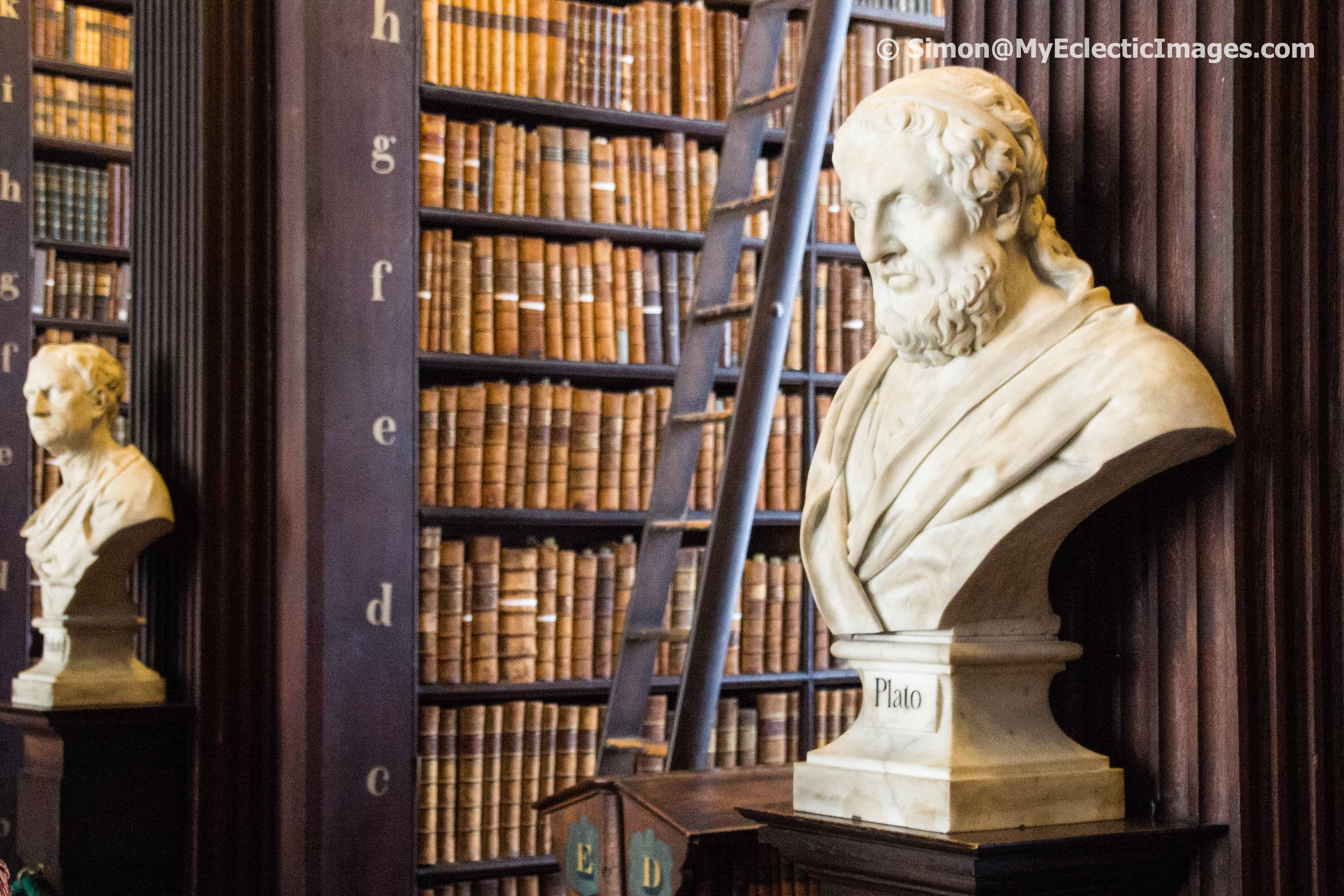
The many treasures of the Long Room also include two of the 50 surviving copies of the 1916 Proclamation of the Irish Republic. The document was read in front of the General Post Office on April 24, 1916 by Patrick Pearse at the commencement of the Easter Rising.
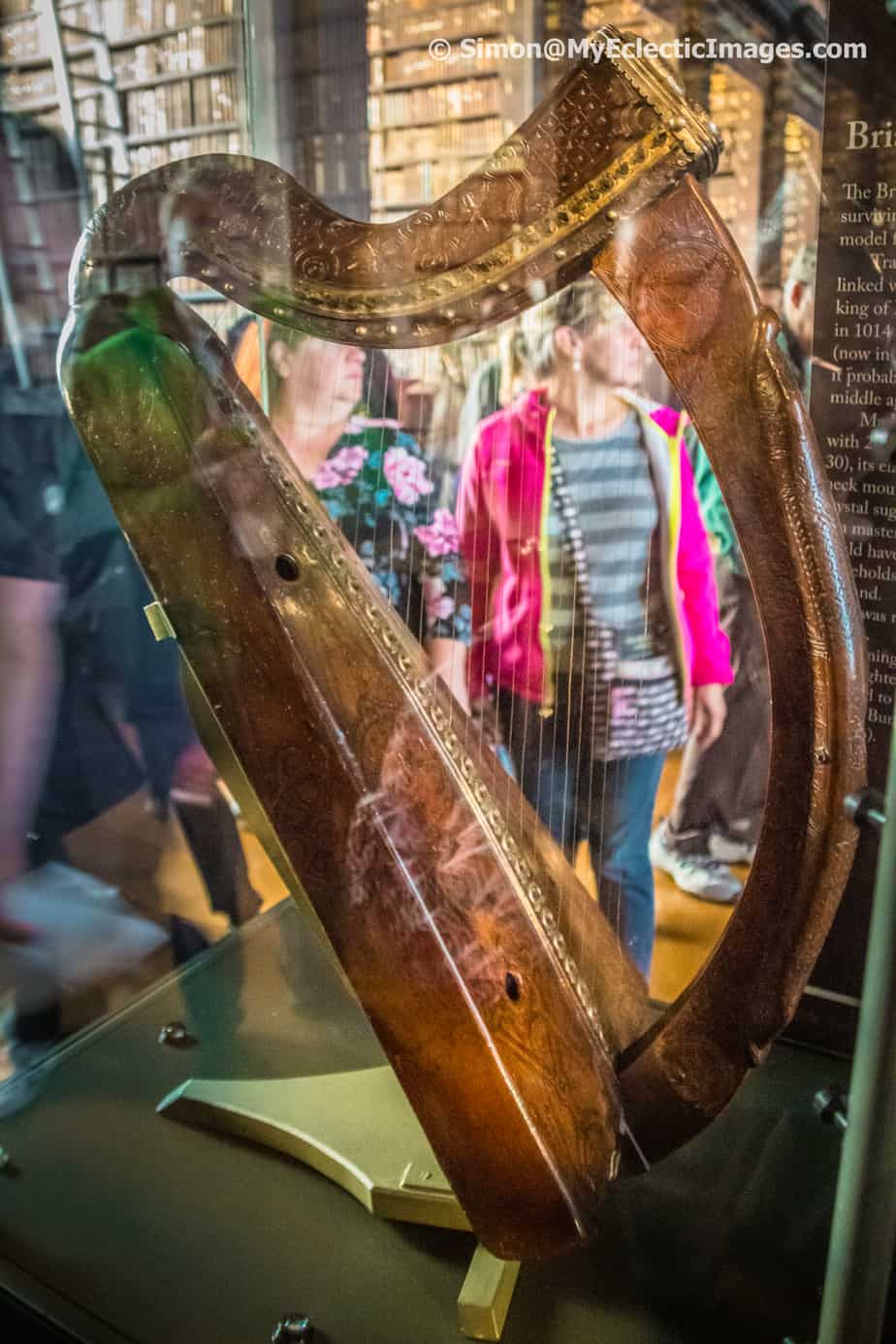
The harp is not only the Guinness trademark, it is the emblem of Ireland. The harp on display in the Long Room is made of oak and willow with 29 brass strings. It is believed to be the oldest of its kind in Ireland, dating back to the 15th century. A replica of this harp was played in the Long Room for Queen Elizabeth and Prince Phillip during their historic 2011 visit to Ireland.
The Old Library is fully functioning, but unlike similar institutions, you enter and leave through the library shop. No matter. The sense of wonder and reverence you experience at the Old Library is priceless.
If You Go
Book of Kells,
Trinity College Dublin,
College Green,
Dublin, Ireland
+353 1 896 2320. bookofkells@tcd.ie
Hours
May – September: Monday – Saturday, 8:30am – 5:00pm
Sunday, 9:30am – 5:00pm
October – April: Monday – Saturday, 9:30am – 15:00pm
Sunday, 12:00pm – 14:30pm
Admission
Adults: €11 – 14 depending on time of day
Family (2 adults and 2 children; 17 and under): €28
Concession (students and seniors over 60): €11
Group: €10 per person
Children under 12: Free
“Keeping the Books” talks: Monday – Friday, 3:00pm in the Long Room are free with admission ticket.
Disclaimer: Our heartfelt gratitude goes out to Fáilte Ireland and all who were involved in our Dublin tour including Dublin libraries for their generosity in making our incredible experiences possible. However, all opinions, as always, are entirely my own.




